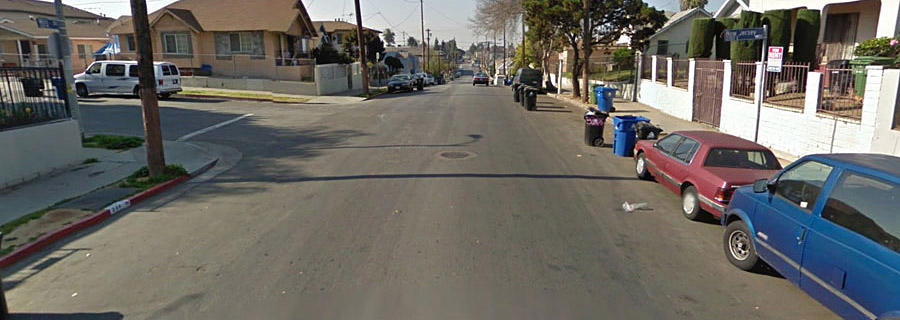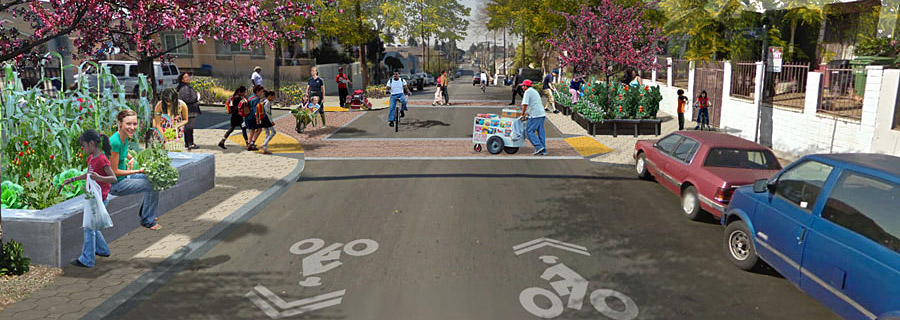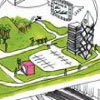


Urban agriculture may be defined as cultivating, processing, preparing and distributing food in or around urban areas. Although food production in cities has a long tradition in most parts of the world, the twentieth century has seen agriculture in industrialized nations become, almost exclusively, a rural activity. While some laudable efforts have been made, especially in inner-city areas, to cultivate food in the public street right-of-way, these instances are rare and largely a success of individual community-driven efforts. This topic looks at how urban agriculture in the right-of-way can be supported to become an important element of the street scene, especially on local neighborhood streets, bringing community gardening and good food to urban people.
Why Urban Agriculture on the Street
All aspects of human development are dependent on adequate access to nutritious food. “Food is a social justice issue and a public health issue; it’s also an economic development issue, it’s a transportation issue, it’s a regional planning issue, it’s an ecological issue.”[1]
By the year 2050, nearly 80% of the earth's population will reside in urban centers. Applying the most conservative estimates to current demographic trends, the human population will increase by about 3 billion people during the interim. An estimated 1 billion hectares of new land (about 20% more land than is represented by the country of Brazil) will be needed to grow enough food to feed them, if traditional farming practices continue as they are practiced today.[2] Agriculture in our urban centers could represent a new direction in food and nutrition policy - one that focuses on health, ecological integrity, job creation and the creation of complete communities.[3]
The potential scale of urban agriculture is enormous. While not a new idea; urban agriculture emerged in the past out of necessity. During World War II, victory gardens were an important food source. Motivations that drive the movement today include: the desire for equity in food supply access across economic divides; health benefits of fresh food; a push to lower transportation costs, carbon footprints and other environmental impacts; self-sufficiency; education; strengthening communities around a shared goal; and the basic need to provide food.
The current applications of urban agriculture are varied and diverse — from community gardens to high-tech vertical gardens, and from cities with highly coordinated and organized agriculture systems and policies to local, grass-roots organizations with little to no governmental support. With the movement to free up land for non-auto related use within existing rights-of-way, streets present a great opportunity for urban agriculture.
The level of support (in terms of regulation and funding) and the type of design necessary to make urban agriculture really work on a large scale is being investigated, discussed and addressed by many cities and towns now.
Cities can and are formally incorporating urban agriculture in the street right-of-way by developing policies that support the participation of community residents in growing food in our streets. Experiments with both emerging and traditional growing techniques are showing that urban agriculture on city streets can provide food for residents and realize all of the social benefits of community gardening and beyond.
Urban agriculture design should aim to meet the following overall goals:
- Improve general health and well-being.
- Improve access to local, reasonably priced and healthy food.
- Increase vegetation and green spaces in neighborhoods.
- Teach and empower people with new skills to grow food.
- Create jobs and support local economic development.
- Enhance community connections and ownership.
- Reduce health costs.
- Educate and cultivate human connection to the food system.
- Strengthen an urban habitat that supports a diversity of insects and animals.
Urban agriculture should be designed to promote a diversity of street activities including but not limited to:
-
Gardening
- Soil prepping
- Mulching
- Planting
- Weeding
- Pruning
- Watering
- Harvesting
- Composting
- Storing
- Preparing/cooking
- Eating
- Distributing
- Educating
- Socializing
Urban agriculture can be categorized in a number of ways based on various factors that include the amount of land available, the ability to use high-tech equipment, and the need to generate revenue. Preliminarily, urban agriculture has been categorized as:
1. Horizontal urban agriculture
- Within areas generally devoted to landscaping such as planting strips, medians, bulbouts, etc.
- More formal and controlled community gardens in small and large, residual spaces spaces that may exist within or along the street right-of-way.
2. Vertical urban agriculture
- Vertical walls, arbors along and over a sidewalk, etc.
- Hydroponic systems.
Depending on the scale and type of vertical or horizontal planted areas, specific needs and opportunities (revenue generation, social equity, improved access to healthy food, etc) must be determined.
A combination of various physical elements and conditions are essential to the design of urban agriculture. This includes but is not limited to:
- Planting containers, such as individual planting pots or fixed and portable grow bins, that can be moved around and placed in car parking spots.
- Planting beds beds that can be either raised or flush with the adjoining sidewalk or pedestrian path. Currently, raised beds are the most common and preferred form of urban agriculture manifesting in sidewalk planting strips and medians. They are relatively easy to build and maintain, and the soil quality and content is known. Raised beds also allow greater sun exposure, generally ensure efficient use of water, crowd out weeds, can include drainage that is built into the bed walls, and keep soil in place and eliminate erosion. Manual labor tasks, such planting, weeding and harvesting, are easier if the bed is raised.
- Vertical planting structures, such as walls, trellises and vertically stacked cells, provide opportunities for planting where space and access to sunlight is limited.
- Fencing creates a controlled environment so plants are not abused by humans or animals.
- An assured water source is essential to the growth of healthy plants. Depending on climate, the plants could be rain-fed, hand-watered or water can be provided with an irrigation system. Each method has advantages, and traditionally hand-watering is considered an enriching aspect of growing plants.
- Irrigation systems can be very simple systems that provide consistent water, which is important for seedlings and leaf crops.
- Storage bins or structures to store tools and other supporting equipment. If the urban agriculture production is at a large scale, refrigerated storage becomes important to maintain perishables.
- Compost bins to decompose and recycle organic matter so that it could be used as a fertilizer and soil amendment.
- Power source (electricity, gasoline, solar panels, windmill, etc.) to power the mechanized irrigation systems, additional lights, equipment, etc.
- Furniture, such as tables and seating, that supports various activities, such as picnicking and educational programs. Seating could include a variety of options, including seat walls (as part of raised beds), benches and movable chairs.
- Structures, such as arbors, pergolas, etc., that could be used for multiple activities including picnicking and growing food vertically.
- Meeting space that allows for farmer markets, picnics, cooking demonstrations, etc.
- Loading and unloading space for vehicles, etc.
- Other potential elements, such as a barbecue grill, cold frame, signage, shared food storage bin, potting station, root shed, etc.


